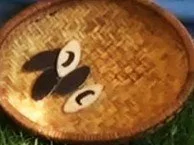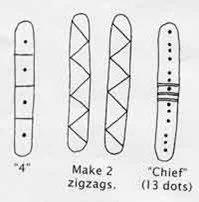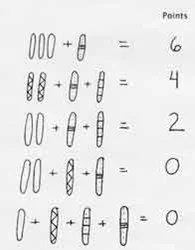Dice Game
By Celeste Halliwell with Mary Ellen Little Mustache
“This is the Dice game. There are stories behind Dice game, and there are songs. Dice game was predominantly a women’s game. The Blackfoot people would use ribs from buffalo to carve out disks to be used for dice. We believe it was a game from the moon and stars, so we would mark the dice to look like the moon and the stars” [1].
“When we play, we shake the baskets containing the dice then compare the dice to the patterns presented here. There are five Dice in each basket. If we have a match to one of the patterns, we receive one, two, or three points depending on the pattern. The winner then receives sticks depending on the score” [1].
“I didn’t score, so I am passing on the basket for the next player to shake” [1].
“The baskets are all of different shapes and sizes but have a ridge high enough to keep the dice contained. We pass on the baskets, so players don’t get to know one basket too well and get an equal opportunity to use each basket. The game is over when all of the sticks are distributed out to the winners. The one with the most sticks wins that round” [1].
“When we play these games, we usually laugh as hard as we can” [1].
Native American games of chance include Dice games and guessing games [2]. In general, observations have noted that dice games are objective and usually played in a quiet atmosphere, whereas guessing games are subjective (e.g. Rock in the Fist or Hand/Stick Games) and are played amongst boisterous noises of singing and drumming with the intent to distract opponents’ guesses. The main two elements for playing the dice game are the decorated dice, or plum stones, and sticks to keep score [2].
In the past, four straight buffalo rib bones would be carved to have a tapered end. Three bones would be marked on one side and the fourth contained three or five transverse groves on the side to tie a buckskin string. All lines, groves and marks were painted red, blue, or black [2]. After the dice (sticks) were tossed and fell to the ground, patterns were revealed:
Certain patterns correspond to specific scores. The object for a game with sticks was to obtain all 12 scores form the designated patterns (Aboriginal Perspectives, 2025).
The Blackfoot also called this game “Travois Gambling or Travois Game” that was played by women [4,6]. The sticks made from bone were known as two, six, and snakes (figure b) [4], or sticks were also named blanks, “4”, zigzag and “Chief” as seen in figure (a) [6]. The opposite side of the sticks were blank giving eight sides in total. Initially, twelve sticks or counters are placed on the ground between two players (or two teams). The first player is sometimes determined by a throw, will grab four bones in the right or left hand and scatter them on the ground to reveal a pattern [6]. As long as the throw displays a score, that player can remain in the game. If no score is achieved, the bones are passed to the opposite player who will continue to throw until a pattern reveals no score. The sticks are used for score keeping and can be taken from an opponent during continuous play. The winner of the game is the one who has accumulated all 12 sticks [6].
Neighboring tribes were known to play similar games called plum stones.
Playing the dice game was known to enhance player’s perceptions around mathematics, probabilities and data management [3].
Executive functions in dice games are necessary to generate effective gambling decisions based on game rules in addition to monitoring and updating results of further throws of the dice [5]. Processing the feedback from each throw is necessary to determine whether bets in gambling are efficient for optimal gains. If a new strategy is necessary, shifts in attention for strategy and play will be required with additional throws of the dice [5]. Working memory is also ongoing to maintain scoring and probabilities of combinations revealed by the dice.
“For those wishing to make their own game set, each die is called cookies at the Dollar Store or Hardware store. I mark them according to what is displayed on the pattern. This is one of the games that represents how we can still have a good time with inexpensive items, especially for those who are not well off” [1].
References
Mary Ellen Little Mustache, In discussion, August 2025.
Culin, S. (1992). Games of the North American Indians. Volume 1: Games of Chance. (Pg 44, 45, 56).
Aboriginal Perspectives. Retrieved online September 2025 from: Stick Game.
Retrieved online September 2025 from: Blackfoot Gambling – Access Genealogy.
Schiebener, J., Zamarian, L., Delazer, M., & Brand, M. (2011). Executive functions, categorization of probabilities, and learning from feedback: What does really matter for decision making under explicit risk conditions? Journal of Clinical and Experimental Neuropsychology, 33 (9), 1025–1039.
Hungy Wolf, A. (2006). The Blackfoot Papers: Pikunni History and Culture. Vol. 1. (Pg. 113). Adolf Hungry Wolf , Good Medicine Cultural Foundation: by Friesens (www.friesens.com), Canada.








